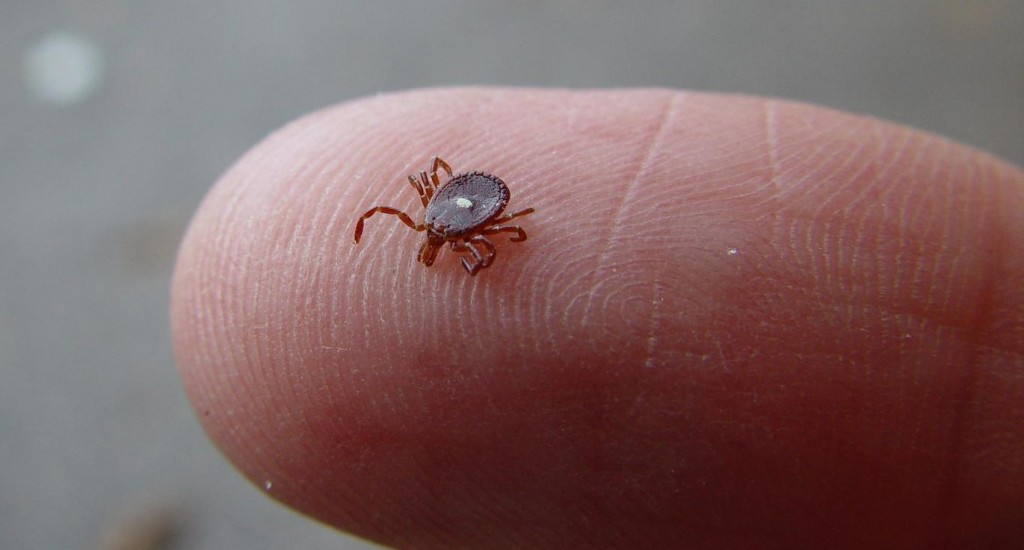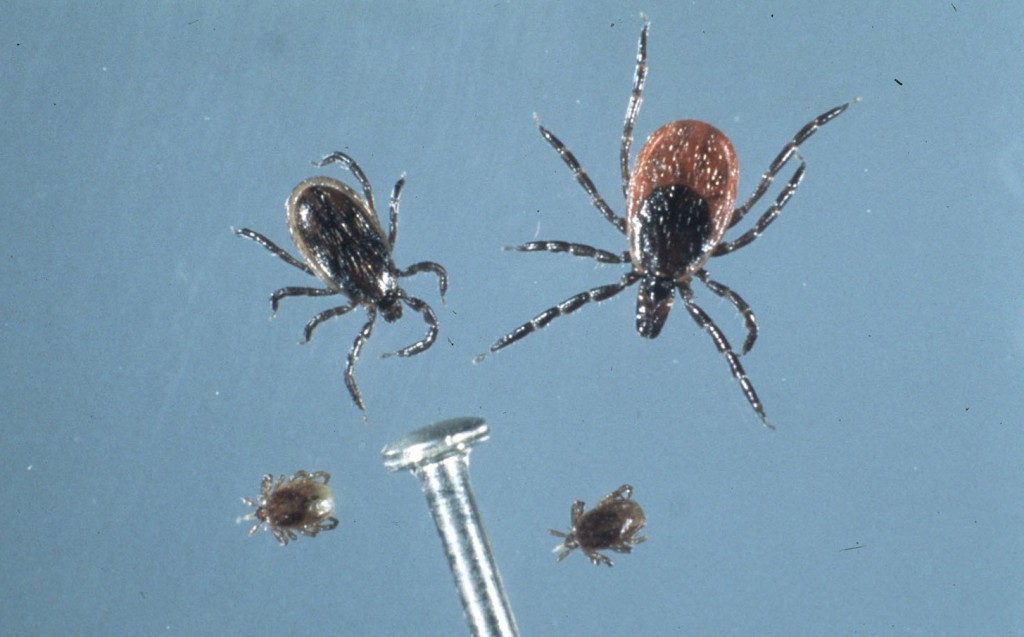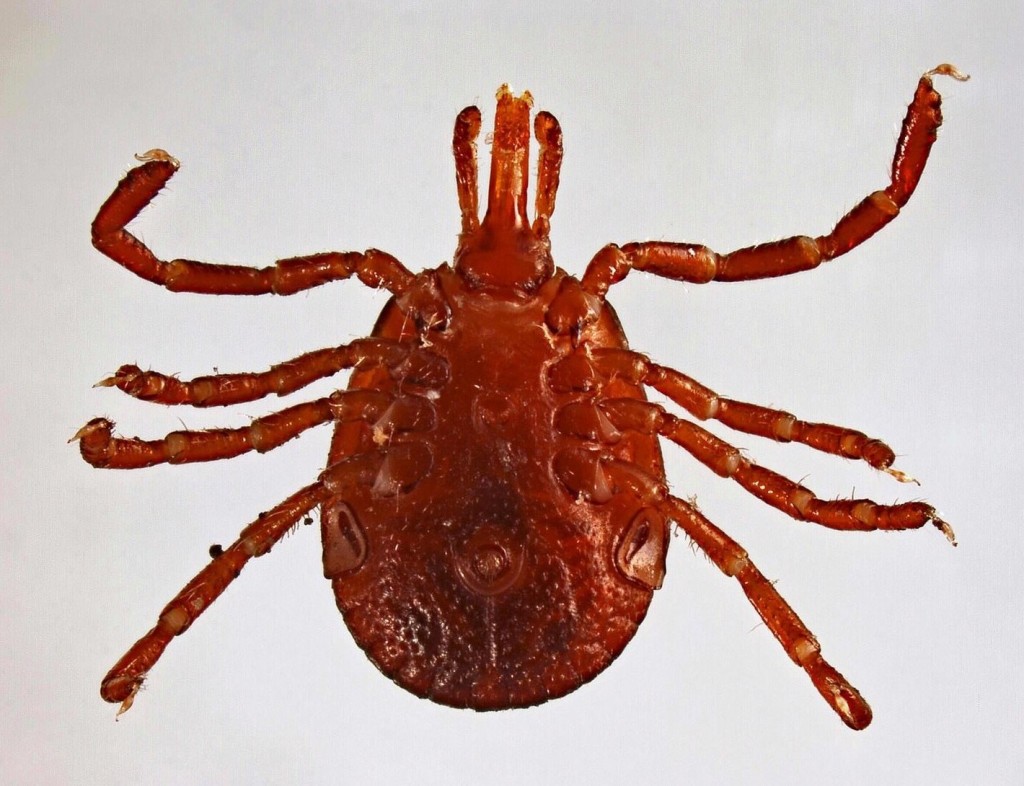Don’t Get Ticked Off When Trekking Along A Trail.
The birds are singing and flying about catching insects. Summer wildflowers are blooming along the trail. You, your family and dog are taking a walk in the woods enjoying nature away from cell phones, texts, Facebook, etc. Then you feel something crawling quickly up your leg or you find a tick in your child’s hair. Now you spend the rest of the day running your hands through your hair and can’t wait to get home to check everyone for ticks that may have attached. Welcome to Southern Illinois in the summer.
Ticks likely originated in the Cretaceous period or 65 to 145 million years ago and went through their primary evolution 5 – 65 million years ago. Ticks, along with spiders and mites are part of the Class Arachinida, and are further classified into the Superorder Parasitiforms, a strong hint that they are a parasite, and must have a host to exploit. Ticks are ectoparasites, that is they live and feed on the outside of the host, consuming the blood of mammals, birds and sometimes reptiles and amphibians.
There are three families of ticks: Ixodidae containing greater than 700 species of hard ticks that are hard to crush and have a beak like structure at the front with mouthparts; the Argasidae family has greater than 200 species of soft ticks that have a mouth on the underside of a soft body; and the Natlallielidae which has only one species and that only occurs in southern Africa.
All ticks have a four-stage life cycle (egg, nymph, larvae, and adult). All stages except the egg are capable of ingesting blood. Moisture is required for the ticks to undergo metamorphosis from one life stage to another. Low temperatures will inhibit the change from egg to the larvae stage. They are obligate hematophages (literally blood-eating) meaning they must have blood to survive and move from the nymph, then larval, and finally to the adult stage. Without a blood meal, they cannot transform and, while they can fast for long periods of time, they eventually will die without transforming, or mating. Hard ticks require three hosts and take at least one year to complete their lifecycle. Some soft tick species undergo up to seven molts during their nymph stage alone and need a new host for a blood meal each time.
Ticks can’t fly or jump and can’t walk about for great distances, so they generally wait on grasses or brush until they detect odors, chemical smells, temperature (heat) or changes in air currents or vibrations. Nymphs and larval stage ticks usually are closer to the ground and attach to smaller hosts, while adults ticks tend to lurk higher on shrubs or trees and to attack larger hosts. Some ticks will attach quickly while others crawl about and look for thin skin. Feeding can begin in 10 minutes or up to two hours later Once at an agreeable spot on a host, a tick cuts a hole in the skin and inserts its feeding tube, a mouthpart adaptation, to draw blood. The tick secretes a chemical anticoagulant to keep the blood flowing and prevent scabbing. Most species also secrete a cement-like bonding material to keep themselves attached. And, many ticks also secrete a form of anesthesia to prevent the host from feeling the cut.
Widely distributed around the world, especially in warm and humid climates, ticks exist wherever their hosts are found. Humidity is needed to allow eggs to hatch without drying out and colder climates can inhibit egg hatching. Warmth, humidity, and plenty of hosts make for tick heaven. Some recent research modeled ideal tick habitat and found the presence of sandy soils in areas with hardwood trees with rivers and plenty of deer made the best predictors of high tick population numbers.
Southern Illinois is a prime habitat for hard ticks, essentially that “tick heaven” that allows for dense tick populations. The humidity is high to keep them hydrated and allow for growth. Prime habitat of wooded and grassy areas and cover provided by species such as invasive bush honeysuckle support a high deer population that serves as the primary food source host to ticks
Ticks’ feeding method – that exchange of blood and saliva – makes them vectors for disease-causing pathogens. Ticks that bite an infected animal can then transmit the bacteria, virus or parasite to their next host. The Centers for Disease Control lists more a dozen known ailments in the U.S. that ticks can transmit. The trends in tick-borne disease are worrisome with a steady increase in disease incidence and the discovery of new tick-borne illnesses. Some ticks can transmit more than one disease, making actual diagnosis of an ailment even more complicated.
Ticks are a simple fact of life, especially so here in Southern Illinois. But tick-borne illness can be avoided, while still enjoying our great outdoors. A good knowledge base is a good beginning — for example, knowing that disease transmission is nearly impossible unless a tick has been attached and feeding for at least 24 hours – allows a hiker to enjoy the day, rather than obsess over the “creepy-crawlies.” Similarly, knowing that ticks wait on and in brush means that the smart hiker keeps herself, her children, and pets ON the trail, where they are far less likely to become a meal for a waiting tick.
Insect repellent, proper clothing, regular “tick checks,” and prompt and proper tick removal all are sound methods to maintain health and enjoy outdoor summer fun.
Learn more about tick species found in Illinois, the diseases they carry and how to treat those diseases. A seminar sponsored by Clifftop will be held Saturday, June 24 from 1 to 3 PM at the Monroe County Annex Building, 901 Illinois Ave, Waterloo, IL.
Board members Susan Rick will discuss general facts about ticks found in our area and Steve Gonzalez will give a first-hand account of living with Lyme disease. Dr. Sean Lattimore, DO, of Progressive Family Care will discuss the pathophysiology of tick-borne illnesses, the types of tick vectors and the associated illnesses related to the specific bacteria, virus and parasites which ticks may carry. In particular he will discuss Lyme disease, Rocky Mountain Spotted Fever, Ehrlichiosis and other commonly seen illnesses related to a tick bite. A discussion of approaches to reduce the risk of tick exposure to those working outdoors, to outdoor enthusiasts, and even those who enjoy their backyards, will take place. The program is free and open to the public. Registrations are required by June 19 and may be made by email to cliffmbr@htc.net or by calling (618) 935-2542.
CLIFFTOP, a local nonprofit organization, is focused on preserving and protecting area bluff lands.
A version of this article appeared in the 2 June 2017 edition of the Monroe County Independent.
© 2017 all content rights reserved Clifftop NFP
Comments are currently closed.



